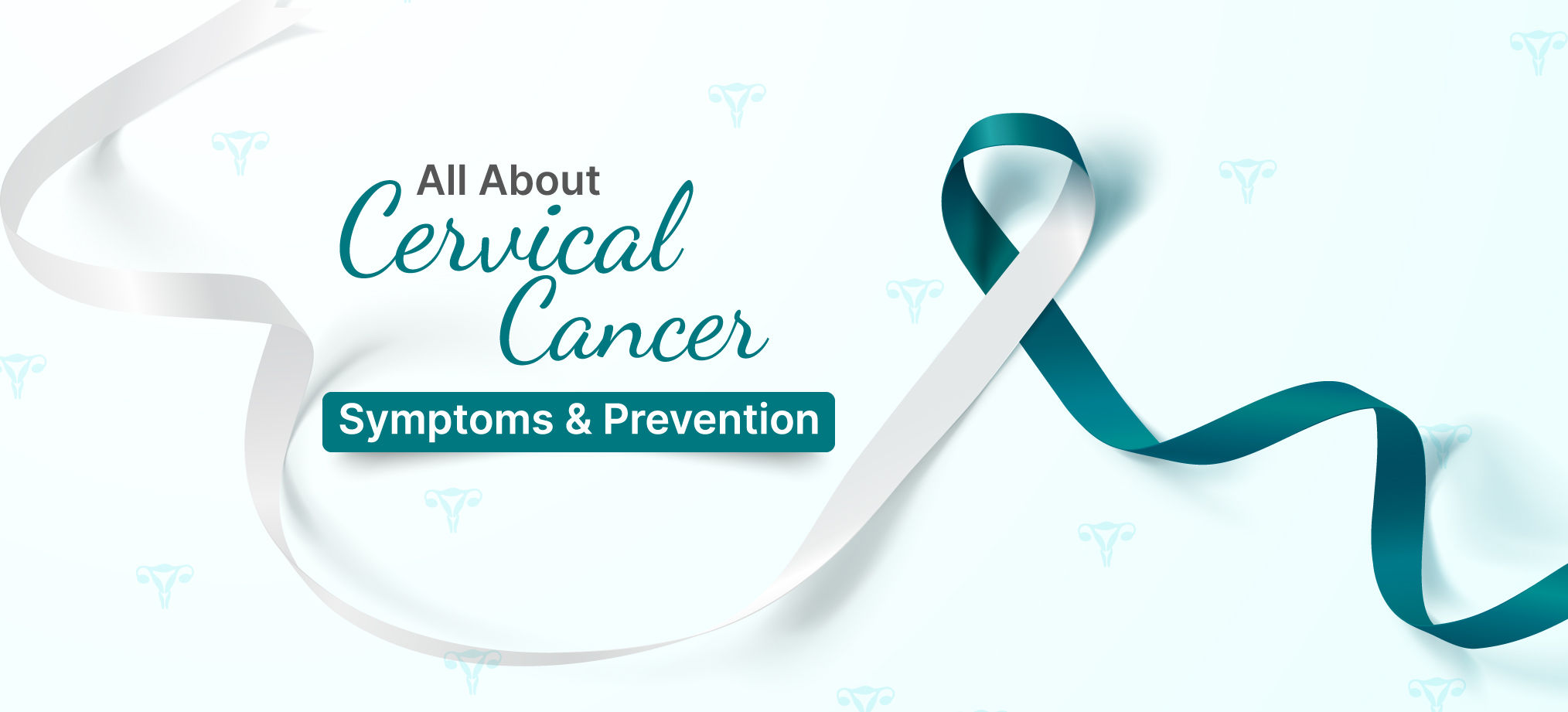Women's Wellness
Cervical Cancer Guide 101: Symptoms, Screening and Prevention
4 min read
By Apollo 24|7, Published on - 18 April 2023, Updated on - 22 May 2024
Share this article
0
0 like

Cervical cancer is the 4th most common type of cancer detected in women globally. It usually begins in the cervix, which is a hollow cylindrical organ connecting a woman's vagina to the lower part of her uterus. In the majority of cervical cancer cases, the cells of the cervix start changing to precancerous cells. Though not all precancerous cells turn into cancer, it's vital to find these precancerous cells and treat them before they get a chance to mutate. Read on to learn more about the symptoms, risk factors, screening and prevention of cervical cancer.
Cervical Cancer Symptoms
Many women suffering from cervical cancer don’t even realise they have cancer initially. This is because it doesn’t cause any symptoms until it reaches the late stages. When the symptoms do occur, they are often mistaken for urinary tract infections (UTIs) or menstruation. Some common symptoms of cervical cancer include:
- Pain in the pelvis
- Unusual bleeding, like after sex, between periods, or after menopause
- Frequent need to urinate
- Vaginal discharge that appears or smells unusual
- Pain during urination
Cervical Cancer Tests
Screening is used for detecting early cancers or precancerous changes before their symptoms appear. Innovation in medical and diagnostic science has led to the development of tools and tests that can help screen an individual for various kinds of cancer before the symptoms occur. Some of the procedures and tests that are used to detect cervical cancer include:
1. Pap Test
Also referred to as pap smear, a pap test is the most common test done to detect early changes in the cells that can result in cervical cancer. This test involves getting a cell sample from the cervix. It is often performed during a regular gynaecological checkup.
2. HPV Test
This test is performed on a cell sample taken from the cervix. This sample is tested to check for the strains of human papillomavirus (HPV) that are most commonly associated with cervical cancer. You can also collect the sample for your HPV test yourself.
3. Visual Inspection with Acetic Acid (VIA)
This test involves the application of diluted white vinegar on the cervix. When exposed to vinegar, any abnormalities on the cervix turn white. This test must not be performed without the guidance of your healthcare provider.
Risk Factors for Cervical Cancer
The biggest risk factor for cervical cancer is HPV. However other factors that can also make you more susceptible to cervical cancer include:
1. Obesity
Excessive body weight increases inflammation in the body and causes hormonal imbalance, both of which can raise the risk of cervical cancer.
2. Smoking
Smoking weakens your immunity, thus failing to fight against HPV. This increases the risk of developing cervical cancer.
3. Family history of the disease
Those with a family history of cervical cancer are at increased risk of developing the same due to genetic mutations or environmental factors.
4. Intake of birth control pills
Long-term use of birth control pills may increase the risk of developing HPV.
5. Teen pregnancy
Research shows women who conceived or delivered a baby before the age of 20 years are more likely to get cervical cancer.
6. Three full-term pregnancies
Research shows that as compared to women who had never given birth, those with three or more full-term pregnancies were 2.6 times at higher risk of developing cervical cancer.
7. Sexually Transmitted Diseases (STDs)
Those with STDs like chlamydia or HIV (Human Immunodeficiency Virus) are at increased risk of developing cervical cancer.
Having one or multiple risk factors does not guarantee cervical cancer. It just means that you should be more cautious and get yourself screened regularly.
How to Prevent Cervical Cancer?
There are a few steps you can take for cervical cancer prevention:
1. The first and foremost step towards the prevention of this cancer is getting regular pap smears and gynaecological exams. This will help in detecting precancerous cells, allowing you to get them treated before they can turn cancerous.
2. As HPV infection is the biggest risk factor for cervical cancer, focus on preventing it. This can be done by getting the HPV vaccine before an individual becomes sexually active. While cervical cancer is only a risk for women, both men and women can get HPV infections, which is why both should get vaccinated.
3. Use condoms or some other barrier method of birth control during vaginal, anal, or oral sex to reduce the risk of STDs.
Explore Sexual Wellness Products
4. Cigarettes not only increase your risk of cervical cancer but also other forms of respiratory diseases. Stop using tobacco products and smoking. You can also try nicotine gums or patches to aid smoking cessation.
Explore Nicotine-Based Products
Cervical cancer is quite common among women, irrespective of their age. So, it’s highly advisable to get regular screening tests done to prevent the development of this disease or to identify it early.
Medically reviewed by Dr Sonia Bhatt.
Leave Comment
Recommended for you

Women's Wellness
5 Tips to Conceive Easily
With family planning taking a back seat, planning pregnancy is getting increasingly stressful for 21st-century couples. If you are ready to take the parental plunge but facing challenges to conceive, hook on to this blog to discover 5 easy tips.

Women's Wellness
Incidence of Gestational Diabetes amid Summer and COVID-19
Scientists recently established that hot weather could also increase the risk of diabetes in pregnant women. It also investigated and recorded the impact of COVID-19 on gestational diabetes.

Women's Wellness
Hormonal Imbalance In Women: Know The Causes, Signs And Ways To Manage It
Hormonal imbalance can result in symptoms like mood swings, and insomnia. Hormonal imbalances can be managed by making dietary changes, exercising regularly, etc.
Subscribe
Sign up for our free Health Library Daily Newsletter
Get doctor-approved health tips, news, and more.
Recommended for you

Women's Wellness
5 Tips to Conceive Easily
With family planning taking a back seat, planning pregnancy is getting increasingly stressful for 21st-century couples. If you are ready to take the parental plunge but facing challenges to conceive, hook on to this blog to discover 5 easy tips.

Women's Wellness
Incidence of Gestational Diabetes amid Summer and COVID-19
Scientists recently established that hot weather could also increase the risk of diabetes in pregnant women. It also investigated and recorded the impact of COVID-19 on gestational diabetes.

Women's Wellness
Hormonal Imbalance In Women: Know The Causes, Signs And Ways To Manage It
Hormonal imbalance can result in symptoms like mood swings, and insomnia. Hormonal imbalances can be managed by making dietary changes, exercising regularly, etc.
